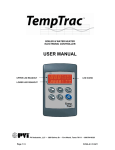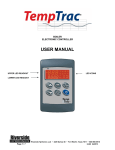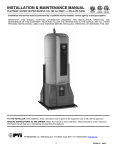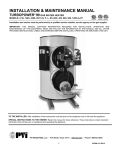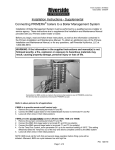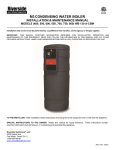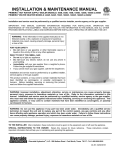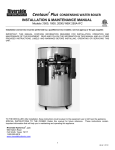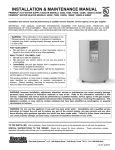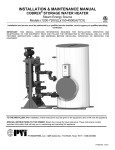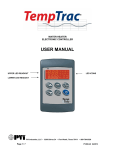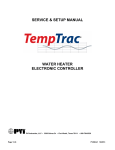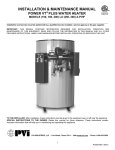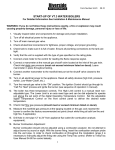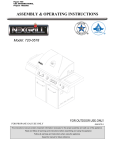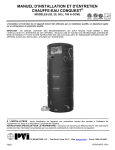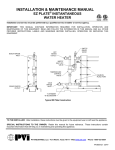Download Installation & Operation Manual (399 to 800 MBtu)
Transcript
INSTALLATION & MAINTENANCE MANUAL CONQUEST® WATER HEATER MODELS (50, 60, 70, 80) L 130 A-GCML MODEL (40) L 130 A-GCL Installation and service must be performed by a qualified service installer, service agency or the gas supplier. IMPORTANT: THIS MANUAL CONTAINS INFORMATION REQUIRED FOR INSTALLATION, OPERATION AND MAINTENANCE OF THIS EQUIPMENT. READ AND FOLLOW THE INFORMATION IN THIS MANUAL AND ALL OTHER PROVIDED INSTRUCTIONS, LABELS AND MARKINGS BEFORE INSTALLING, OPERATING OR SERVICING THIS UNIT. TO THE INSTALLER: After installation, these instructions must be given to the equipment user or left near the appliance. SPECIAL INSTRUCTIONS TO THE OWNER: Retain this manual for future reference. These instructions contain important information that will help you in maintaining and operating this appliance. PVI INDUSTRIES, LLC - Fort Worth, Texas 76111 - Web www.pvi.com - Phone 1-800-433-5654 PV500-60 07/15 CONQUEST® WATER HEATER TABLE OF CONTENTS 1. Safety Considerations 2. Product Description 3. Water Heater Installation 4. 5. 3.1 Checking Equipment Before You Install 3.2 Codes 3.3 Electrical Requirements 3.4 Handling and Locating the Water Heater 3.5 Clearances to Combustible Surfaces 3.6 Service Clearances General Piping Guidelines 4.1 Inlet and Outlet Connections 4.2 Building Return Piping Condensate Drain, Trap & Disposal 5.1 6. Gas Supply and Piping 6.1 7. 8. Condensate Neutralization System (optional) Gas Train and Controls Certification 6.2 Gas Control Trains 6.3 Inlet Pressure 6.4 Manifold Pressure 6.5 Gas Piping Size 6.6 Appliance Isolation During Gas Supply Piping Pressure Test 6.7 Gas Connection Combustion and Ventilation Air 7.1 Equipment Located in Confined Spaces 7.2 Maximum Allowed Remote Combustion Air Inlet Length 7.3 Remote Combustion Air Cap 7.4 Vertical or Horizontal Remote Air Duct Termination 7.5 Combining Remote Air Ducting 7.6 Optional Filter Box for Dusty or Dirty Combustion Air Venting 8.1 Venting the CONQUEST 8.2 Maximum Vent Length 8.3 Vertical or Horizontal Vent Termination 8.4 Combining Category IV Vent 8.5 Concentric Vent for Combustion Air and Exhausting Flue Products 8.6 Connecting to an Existing Vent System 2 PV500-60 07/15 CONQUEST® WATER HEATER 9. 10. Operating and Safety Controls 9.1 Temperature and Pressure Relief Valve(s) 9.2 Cathodic Protection 9.3 Electronic Low Water Cut-off 9.4 Operating Temperature Control 9.5 High Water Temperature Limit Control TEMPTRAC Electronic Controller Panel 10.1 Principal of Operation 10.2 Upper LED Readout 10.3 Lower LED Readout 10.4 Control Buttons 10.5 To View the Setpoint 10.6 To Change the Setpoint 10.7 To Change Other Parameters 10.8 LED Display Alarm Messages 11. Remote Connections – Terminal Strip 11.1 Making BMS/BAS Remote Connection for Analog and Binary Signals 11.2 Terminal Functions 12. Sequence of Operation 13. Initial Startup 13.1 Initial Startup Requirements 13.2 Tools and Instrumentation Required 13.3 Resources 13.4 On Site Considerations 13.5 Startup Procedure 14. NSF Food Service Installation Guidelines 15. Troubleshooting Guide 16. Replacement Parts 16.1 Burner Assemblies 16.2 Control Panel Enclosure Component Layout and Replacement PN’s 16.3 Component Wiring and Conduit Routing Details 17. Periodic Maintenance 18. Recommended Maintenance Schedule Warranty forms ship separately with each product. 3 PV500-60 07/15 CONQUEST® WATER HEATER 1 SAFETY CONSIDERATIONS WARNING: If the information in the supplied manual(s) is not followed exactly, a fire, explosion or exposure to hazardous materials may result, causing property damage, personal injury or death. FOR YOUR SAFETY • Do not store or use gasoline or other flammable vapors or liquids in the vicinity of this or any other appliance. WHAT TO DO IF YOU SMELL GAS • Do not try to light any appliance. • Do not touch any electric switch; do not use any phone in your building. • Immediately call your gas supplier from a location away from your building and the smell of gas. Follow the gas supplier's instructions. • If you cannot reach your gas supplier, call the fire department. Installation and service must be performed by a qualified installer, service agency or the gas supplier. This product contains, or may come to contain materials that have been identified as carcinogenic, or possibly carcinogenic to humans. Before installing, servicing or removing this product, read and follow the supplied instructions WARNING: Installation and service must be performed by a qualified installer, service agency or the gas supplier, who must read and follow the supplied instructions before installing, servicing or removing this appliance. Refer to the information contained in this manual. Improper installation, adjustment, alteration, service or maintenance can cause property damage, personal injury, exposure to hazardous materials or death. WARNING: Do not use this appliance if any part has been under water. Immediately call a qualified service technician to inspect the unit and to replace any part of the control system, all gas controls and all other items affecting safe appliance operation and which has been under water. WARNING: In an emergency shut the main gas supply valve to the appliance from a location safely away from the emergency. Failure to follow these instructions can cause property damage, personal injury, and exposure to hazardous materials or death. PRODUCT SAFETY INFORMATION REFRACTORY CERAMIC FIBER PRODUCT WITH CRYSTALLINE SILICA WARNING: This product contains or may come to contain crystalline silica, which has been identified by the International Agency for Research on Cancer (IARC) as carcinogenic to humans. This product also contains refractory ceramic fibers, which have been identified by the IARC as possibly carcinogenic to humans. Avoid breathing fiber particulates and dust. RISKS: • Air borne fibrous insulation is a possible cancer hazard by inhalation. • Airborne crystalline silica may cause silicosis (lung disease) by inhalation. • May cause temporary irritation to eyes, skin, and respiratory tract. PRECAUTIONARY MEASURES: • Minimize airborne fibers with engineering controls. • Use NIOSH/MSHA approved respirators as required (see MSDS). • Wear long sleeved, loose-fitting clothing, eye protection and gloves. FIRST AID MEASURES: (If any of the irritations listed persists, seek medical attention) • Eyes: Flush with water. • Skin: Wash with soap and warm water. • Ingestion: Do not induce vomiting. Get medical attention if gastrointestinal symptoms develop. • Inhalation: Remove to fresh clean air. WARNING: If you are unfamiliar with the safe handling of refractory ceramic fiber products, or if you wish additional information prior to beginning any disassembly of the water heater or boiler that might expose refractory ceramic fiber materials, contact: Unifrax Corporation, 2351 Whirlpool Street, Niagara Falls, NY 14305-2413, 1-800-322-2293. IDENTIFICATION OF REFRACTORY CERAMIC FIBER MATERIALS (RCF): The burner assembly utilizes RCF material. (The RFC materials are located within the product and not generally exposed except during service, disassembly or assembly.) 4 PV500-60 07/15 CONQUEST® WATER HEATER IMPORTANT SAFETY NOTE It takes only 5 seconds of skin contact with 140°F water to cause a second degree burn! You must protect against high water temperatures at all lavatories, tubs, showers and other points of hot water contact. Accidental scalding from high water temperatures is a greater risk in some types of installations. Some examples are: HOMES FOR THE MENTALLY HANDICAPPED HOMES FOR THE PHYSICALLY HANDICAPPED HOSPITALS AND NURSING HOMES ELDER CARE FACILITIES AND REST HOMES ORPHANAGES AND CHILD CARE FACILITIES OTHER INSTALLATIONS - WHERE RESPONSE TO CONTACT WITH HOT WATER MAY BE SLOWER OR WHERE THE DANGER OF HOT WATER CONTACT IS GREATER Thermostatically controlled mixing valves must be used in the design of the potable hot water system. Potable hot water should be tempered to no more than 110°F when used for bathing or other personal uses. Good engineering practice mandates the use of thermostatically controlled mixing valves set at 120°F or less to keep the delivered water temperature below scalding temperatures. 5 PV500-60 07/15 CONQUEST® WATER HEATER 2 PRODUCT DESCRIPTION Component, Controls and Connection Locations (Locations May Vary) 6 PV500-60 07/15 CONQUEST® WATER HEATER 3 WATER HEATER INSTALLATION 3.1 Checking Equipment Before You Install • Inspect the unit completely upon receipt from the freight carrier before signing the bill of lading. Inspect the appliance and all accompanying parts for signs of impact or mishandling. Verify the total number of pieces shown on packing slips with those actually received. Contact the freight carrier immediately if any damage or shortage is detected. • Check the data decal on the appliance. Be sure the electrical, water and gas supply is adequate for the installation. • Carefully remove all side and top shipping supports and bracing. If possible, do not remove the wooden base/skid assembly until the product has been moved to its final location for installation and operation (see: Handling and Locating the Water Heater). 3.2 Codes The equipment must be installed in accordance with those installation regulations in force in the local area where the installation is to be made. Authorities having jurisdiction must be consulted before installation is made. In the absence of such requirements, the installation shall be in accordance with the instructions in this manual, appliance markings and supplemental instructions and in compliance with the latest edition of the National Fuel Gas Code, ANSI Z223.1. Where required by the Canadian authority having jurisdiction, the equipment must be installed in accordance with the latest edition of the Installation Code for Gas Burner Appliances and Equipment CAN/CSA B149.1 and/or B149.2 and applicable Provincial Regulations. All appliances conform to the current edition of the ASME Boiler and Pressure Vessel Code, Section IV, Part HLW. 3.3 Electrical Requirements See appliance rating decal for electrical service requirements. The appliance must be electrically supplied and grounded in accordance with the requirements of the authority having jurisdiction or, in the absence of such requirements, with the latest edition of the National Electrical Code ANSI/NFPA No. 70. In Canada, the electrical service must conform to local electrical codes and/or CSA C22.1, Canadian Electrical Code, Part 1. • All wiring between the unit and field installed devices must be made with type T copper wire. • Line voltage wire exterior to the appliance must be enclosed in approved conduit or approved metal clad cable. • To avoid serious damage, DO NOT energize the unit until the system and appliance is full of water. Utiliser du fil de cuivre de la taille appropriée pour le service électrique entrant. Les dommages résultant de l'utilisation de fil d'aluminium seront exclus du champ d'application de la garantie de cet appareil. 3.4 Handling and Locating the Water Heater WARNING: Use industry standard safe rigging methods, such as strapping around the water heater base/skid assembly and using spreader bars, when attempting to lift or move this product. Failure to follow industry standard safe rigging methods can result in property damage, serious injury or death. 1 2 3 4. 5. The water heater must be located indoors. This water heater can be installed directly on a combustible floor. Locate the water heater in an area that is not exposed to freezing temperatures. Locate on a level surface. Installation on a 4 inch to 6 inch housekeeping pad is recommended. Locate the water heater near a floor drain. Locate the unit so if the tank or water connections should leak, water damage will not occur to the adjacent area or to lower floors of the building. When such locations are unavoidable, install an adequately drained metal drain pan underneath the water heater. The manufacturer’s warranty does not cover water damage. 6. Protect associated electrical components and electrical connections from water (dripping, spraying, rain, etc.) during appliance operation and service. 7. Locate the water heater where the vent and air intake piping, when installed, will remain within the maximum equivalent lengths allowed. See Venting. 7 PV500-60 07/15 CONQUEST® WATER HEATER 8. Use the following diagram to locate anchors or attachment points, when connecting the heater to the floor. Typical concrete anchors: 5/16" x 1-3/4" double expansion shield. 3.5 Clearances To Combustible Surfaces The minimum clearance to combustible material is 15" from the top, 24" from the front and zero clearance (0") from the sides and back of the water heater. The Conquest can be installed directly on a combustible floor. Distance minimale aux matériaux combustibles est égale à zéro (0 cm) sur les côtés et à l'arrière, avant les 61 cm, 38 cm de haut et peut être installé directily sur un plancher combustible. 3.6 Service Clearances Additional clearance beyond the minimum required to combustible material should be considered to facilitate easy access for inspection and service of items such as the burner, gas controls and plumbing connections. Also allow sufficient space for installing and servicing building water, gas, vent, combustion air, electrical, pump and other auxiliary/optional equipment and connections. 8 PV500-60 07/15 CONQUEST® WATER HEATER 4 GENERAL PIPING GUIDELINES 4.1 Inlet and Outlet Connections 1. Use only non-ferrous water piping and fittings. Do not use galvanized pipe or fittings. Use of ferrous or galvanized pipe or fittings can cause rust to form. 2. Install shut-off valves and unions on the inlet and outlet water piping for servicing. Use caution when threading pipe nipples into tank connections to prevent cross threading, or over-tightening. Always use a back-up wrench on tank nipples when tightening unions, valves, etc. 3. Insulate hot water and return circulation lines. Insulate cold water supply lines if subject to freezing during shutdown periods. IMPORTANT: Do not use the plumbing connected to the appliance as a ground for welding or any other purpose. 4. Pipe the drain valve to a suitable open drain. IMPORTANT: Cold inlet water to the Conquest should not exceed 100ºF. Do not connect the building return or dishwasher recirculation piping to the cold inlet water supply. The Conquest utilizes cold inlet water to help extract almost all of the heat energy from the products of combustion, which lowers the vent temperature to allow the use of PVC vent pipe. Higher cold inlet water temperatures will reduce heater efficiency and increase the vent temperature. If the vent temperature approaches the maximum allowed, a vent temperature limit switch will cycle the heater off to protect the PVC vent. 4.2 Building Return Piping To maximize water heater efficiency, do not connect the building return or dishwasher recirculation piping (≈ 5 gpm) directly to the cold inlet. Connect directly to the dedicated building return fitting located at the rear of the tank at midtank level. SINGLE WATER PIPING 9 PV500-60 07/15 CONQUEST® WATER HEATER SINGLE STORAGE WATER HEATER WITH SUPPLEMENTAL STORAGE TANK TWO WATER HEATERS WITH REVERSE RETURN PIPING 10 PV500-60 07/15 CONQUEST® WATER HEATER 5 CONDENSATE DRAIN, TRAP & DISPOSAL The Conquest water heater produces a significant amount of condensate. The condensate drain is under slightly positive flue pressure, so the provided 3/4" PVC condensate trap must always be used. This trap is sized and designed to fill with the proper amount of condensate to create a liquid barrier to prevent flue gases escaping through the condensate drain into the installed space. WARNING: The trap included with this unit must be installed as described in these instructions and must be included as part of the condensate piping system. This trap is required to keep hazardous products of combustion from continually entering the installed space where the condensate piping terminates. Failure to properly install this trap can cause, personal injury, exposure to hazardous materials or death. 1. 2. 3. 4. 5. Attach the supplied 3/4" PVC condensate trap to the mating PVC union connection on the water heater condensate drain pipe located near the flue outlet. The trap must be rotated so the offset in the pipe aims down toward the floor. Do not rotate the offset toward the ceiling. Do not use tools to tighten the PVC union. Handtighten the PVC union to seat the internal gasket. Do not combine condensate drains from multiple condensing appliances into a single drain line. Route each drain line into a drain suitable for condensate and make certain the end of the drain lines are not submerged or otherwise blocked. All condensate plumbing must be protected from freezing. Do not locate the condensate piping such that an ice dam of frozen condensate can block condensate from leaving the outlet. The condensate is only slightly acidic (3-5 PH), however, local codes may require it to be neutralized prior to entering the drainage system. An optional, field installed, Condensate Neutralization System is available from the factory. Connect a condensate drain line or the PVI Condensate Neutralization System to the barbed hose connection, sized for 1/2" ID heavy wall Vinyl tubing rated for 170ºF or higher, located at the end of the condensate trap. All piping from the condensate trap to the suitable drain must remain below the highest point (top of the condensate outlet pipe) on the properly attached condensate trap. Condensate Trap Without Optional Condensate Neutralizer 11 PV500-60 07/15 CONQUEST® WATER HEATER 5.1 Condensate Neutralization System (optional) Condensate is only slightly acidic (3-5 PH), however this slight acidity can be neutralized by routing it through an optional PVI Condensate Neutralization System. Some “authorities having jurisdiction” require such neutralization before condensate disposal through a suitable drain. Condensate is neutralized while slowly flowing through a container filled with renewable crushed limestone. The condensate neutralizer reduces or avoids the need for separate chemical treatment or dilution using substantial quantities of tap water. Contact your local PVI representative to obtain a Condensate Neutralization System and follow the instructions included for assembly and connection. Condensate Neutralization Systems (CNS) Installation Requirements: 1. 2. 3. 4. Follow the steps 1 through 6 in the Condensate Drain, Trap & Disposal section above. The Condensate Neutralization System (CNS) must be mounted horizontally and level, with the mounting strap legs on the floor. Locate the CNS in a convenient place between the condensate outlet and a suitable drain and where the 3" threaded end cap can be removed to recharge the Neutralizer with crushed limestone. a. The CNS must be located such that condensate will flow downhill from the condensate trap outlet to the inlet on one end of the CNS and downhill from the other end of the CHS to the drain. If this continuous downhill flow is not maintained, the trap will not properly operate and condensate could back up into the heater. b. Follow the instructions included in the Condensate Neutralization System for connecting the supplied 1/2" Vinyl tubing. Keep the Condensate Neutralization System closed at all times, except for maintenance when the appliance is turned off. WARNING: Keep the Condensate Neutralization System closed at all times the appliance is operating. The system must remain closed to prevent hazardous products combustion from continually enter the room. Failure to keep the Condensate Neutralization System closed during appliance operation can cause property damage, personal injury, exposure to hazardous materials or death. Condensate Trap With Optional Condensate Neutralizer Located On Same Level As Conquest 12 PV500-60 07/15 CONQUEST® WATER HEATER Condensate Trap With Optional Condensate Neutralizer Located Below Conquest 6 GAS SUPPLY AND PIPING Verify the type of gas specified on rating plate is supplied to the unit. This unit is orificed for operation up to 2000 feet altitude. Appliance Btu/h input derates 4% per 1000 feet elevation above sea level. Consult Factory for installations above 2000 feet elevation. 6.1 Gas Train and Controls Certification NOTE: The gas train and controls assembly provided on this unit have been tested under the applicable Nationally Recognized Standard to comply with safety and performance criteria such as ignition, combustion and safety shutdown operation. 6.2 Gas Control Trains All models include the following gas control train components: manual shutoff valve, two safety shutoff valves, zero governor type regulator, manual test valve and manifold pressure taps. These components may be separate or combined in a common housing. WARNING: Do not adjust or remove any screws or bolts on gas train control components which are secured with a red or blue sealing compound. In addition to voiding warranties and certification listings, such adjustment or disassembly can cause improper operation which could result in property damage, personal injury or death. 6.3 Inlet Pressure Measure at the inlet pressure tap located at the main gas cock. The inlet pressure must remain within the minimum and maximum values while the unit is at rest and while the unit is operating at maximum firing rate. INLET PRESSURE Maximum Static Pressure (Inches-Water Column) Minimum Flow Pressure (Inches-Water Column) NAT. GAS 14.0" 3.5" Propane 13.0" 8.0" 13 PV500-60 07/15 CONQUEST® WATER HEATER 6.4 Manifold Pressure Measure at the pressure tap located downstream side of the manual valve closest to the burner. The rated manifold pressure appears on the product data label located near the front of the appliance. 6.5 Gas Piping Size Do not use the gas pipe connection size to determine the gas supply piping. Designing and sizing a gas supply piping system requires consideration of many factors and must be done by a gas supply piping expert. Always follow NFPA 54 National Fuel Gas Code for gas pipe sizing and gas pipe system design. The following charts provide examples of some of the information used by the gas supply piping expert to determine proper pipe sizes. Use the values in the following table to add the equivalent straight pipe for each elbow or tee to obtain the total distance from the meter: CONVERT FITTINGS TO EQUIVALENT STRAIGHT PIPE* Diameter Fitting (inches) ¾" 1" 1¼" 1½" 2" 3" 4" 5" Equivalent Length of Straight Pipe (feet) 2' 2' 3' 4' 5' 10' 14' 20' Use the following table to determine the possible pipe size based on distance from gas meter for a Single Unit Installation using Schedule 40 Metallic Gas Pipe.* SINGLE UNIT INSTALLATION – POSSIBLE SCHEDULE 40 METALLIC GAS PIPE SIZE* Distance from meter in equivalent feet of schedule 40 metallic gas pipe.* Based on inlet pressure less than 2 psi, specific gravity of 0.60 and a pressure drop of 0.5 in. w.c. 0' - 10' 11' - 25' 26' - 50' 51' - 100' 101' - 200' 201' - 300' 301' - 500' MODEL 1" 1" 1-1/4" 1-1/4" 1-1/2" 2" 2" 40 1" 1-1/4" 1-1/4" 1-1/2" 2" 2" 2-1/2" 50 1" 1-1/4" 1-1/2" 1-1/2" 2" 2" 2-1/2" 60 1-1/4" 1-1/4" 1-1/2" 2" 2" 2-1/2" 2-1/2" 70 1-1/4" 1-1/4" 1-1/2" 2" 2-1/2" 2-1/2" 3" 80 *See NFPA 54 National Fuel Gas Code for actual pipe size selection and for sizing Propane gas piping MULTIPLE UNIT INSTALLATIONS SCHEDULE 40 METALLIC GAS PIPE SIZE CHART* Maximum Capacity of Pipe in Thousands of BTU’s per hour for gas pressures of 14 Inches Water Column (0.5 PSIG) or less and a pressure drop of 0.05 Inch Water Column (Based on NAT GAS, 1025BTU’s per Cubic Foot of Gas and 0.60 Specific Gravity).* Nominal Iron Pipe Size, Inches 10 20 30 40 50 60 70 80 90 100 125 150 175 200 3/4 369 256 205 174 155 141 128 121 113 106 95 86 79 74 1 697 477 384 328 292 267 246 256 210 200 179 164 49 138 1 1/4 1400 974 789 677 595 543 502 472 441 410 369 333 308 287 1 1/2 2150 1500 1210 1020 923 830 769 707 666 636 564 513 472 441 2 4100 2820 2260 1950 1720 1560 1440 1330 1250 1180 1100 974 871 820 2 1/2 6460 4460 3610 3100 2720 2460 2310 2100 2000 1900 1700 1540 1400 1300 3 11200 7900 6400 5400 4870 4410 4000 3800 3540 3300 3000 2720 2500 2340 4 23500 16100 13100 11100 10000 9000 8300 7690 7380 6870 6150 5640 5130 4720 Length of Pipe in Straight Feet *See NFPA 54 National Fuel Gas Code for actual pipe size selection and for sizing Propane gas piping 14 PV500-60 07/15 CONQUEST® WATER HEATER 6.6 Appliance Isolation During Gas Supply Piping Pressure Test 1. The appliance and its provided manual shutoff valve must be disconnected from the gas supply piping system during any pressure testing of that system at test pressures in excess of ½ PSI (3.5 kPa). 2. The appliance must be isolated from the gas supply piping system by closing its individual manual shutoff valve during any pressure testing of the gas supply piping system at test pressures equal to or less than ½ PSI (3.5 kPa). 3. The appliance and its gas connection must be leak-tested before placing it in operation. 6.7 Gas Connection 1. Safe operation of unit requires adequate gas supply with the required static and dynamic (flow) pressures. Actual piping selection depends on many variables that must be carefully considered by the gas piping system designer. 2. Do not select gas pipe sizes based only on the supplied tables. These tables are for use by the gas piping system designer as a reference in checking pipe size selections. 3. Gas pipe size may be larger than heater connection. 4. Installation of a union is suggested for ease of service. 5. Install a manual main gas shutoff valve on the gas supply piping connected to the appliance to isolate the burner and gas train from the main supply gas in compliance with NFPA 54 National Fuel Gas Code and most local Codes. 6. The gas system installer must clearly identify the emergency shut-off device. 7. A sediment trap (drip leg) MUST be provided in the inlet of the gas connection to the unit. 8. The combination gas valves and/or gas regulators incorporate either an internal vent limiter or an externally mounted vent limiting orifice and 1/4" aluminum tube located in a “T” attached to the regulator vent port. Venting to outdoors is not required. Never remove, cut, splice or alter the flexible tubing attached directly to the regulator vent port or to a vent limiting fitting attached externally to the regulator, as this will cause unreliable ignition and can cause improper operation. Although not required, a connection to the open end of the 1/4" aluminum tube can be made and routed to the outdoors. No other connection point is allowed. Do not remove the aluminum tubing and connect directly to the “T”, as damage to the required vent limiter and improper gas control could result. 7 COMBUSTION AND VENTILATION AIR Provisions for adequate combustion and ventilation air to the mechanical room must be in accordance with Section “Air for Combustion and Ventilation” in the latest edition of the NFPA 54 National Fuel Gas Code, ANSI Z223.1 and/or CAN/CSA B149, Installation Codes or applicable provisions of the local building codes. Any method addressed in NFPA 54 National Fuel Gas Code section “Air for Combustion and Ventilation is acceptable and several are outlined below. 7.1 Equipment Located In Confined Spaces Equipment located in confined spaces requires two openings, one commencing within 12" (30.5 cm) from the top of the enclosure/room and one commencing within 12" from bottom of the enclosure/room to assure adequate combustion air and proper ventilation. The total input of all gas utilization equipment installed in the room must be used to determine the required minimum air volume needed for combustion, ventilation and dilution of flue gasses. Also consider makeup air requirements from other equipment within the mechanical room or other rooms that are pressure connected with the mechanical room. Some examples of other makeup air requirements are from kitchen exhaust hoods, clothes dryers, powered exhaust fans, etc. • All Air From Outdoors: Each opening requires a minimum free area of 1 square inch per 4000 Btu/hr of the total input rating of all appliances in the enclosure, if directly communicating with the outdoors or communicating to the outdoors through vertical ducts. Each opening requires a minimum free area of 1 square inch per 2000 Btu/hr of the total input rating of all appliances in the enclosure, if communicating with the outdoors through horizontal ducts. 15 PV500-60 07/15 CONQUEST® WATER HEATER • All Air From Inside The Building: Follow the requirements of NFPA 54 National Fuel Gas Code, ANSI Z223.1 section “Indoor Combustion Air.” • Combination Of Air From The Indoors And From The Outdoors: Follow the requirements of NFPA National Fuel Gas Code, ANSI Z223.1 section “Combination Indoor and Outdoor Combustion Air.” • From Outdoors Through One Opening: Follow the requirements of NFPA National Fuel Gas Code, ANSI Z223.1 section “One Permanent Opening Method.” NOTE: This unit may be installed with a remote air intake system which uses a make-up air duct to draw combustion air directly from outdoors. WARNING: Adequate clean combustion air must be provided to the appliance. The appliance must never operate under a negative pressure. Particular care must be taken when exhaust fans, compressors, air handling units, etc. may rob air from the appliance. The combustion air supply must be completely free of any chemical or fumes, which may be corrosive to the appliance. Some common chemical fumes to avoid are fluorocarbons and other halogenated compounds, most commonly present as refrigerants or solvents, such as Freon, trichloroethylene, perchlorethylene, chlorine, etc. These chemicals, when in contact with the equipment or when burned, form acids which quickly attack the tubes, flue collector, stack and other appliance and auxiliary equipment. Failure to provide adequate clean combustion air or operating under negative pressure can cause premature, unwarranted product failure or unsafe operation producing carbon monoxide that could escape into the building. Exposure to carbon monoxide can lead to personal injury or death. 7.2 Maximum Allowed Remote Combustion Air Inlet Length (Equivalent Length) A vertical or horizontal remote air inlet system can be connected to this appliance without modification. The maximum length of field supplied single wall pipe, such as galvanized ventilation pipe, is shown in the chart below titled Maximum Air Inlet Duct Equivalent Length. Use metal tape or RTV sealant to seal each pipe joint. Maximum Air Inlet Duct Equivalent Length / Max Elbows Duct Size Max Equivalent Length Model 40 Max Equivalent Length Model 50 Max Equivalent Length Model 60 - 80 4" Duct 125 feet / 4 80 feet / 3 N/A 6" Duct 200 feet / 10 200 feet / 10 250 feet / 10 8" Duct 300 feet / 10 300 feet / 10 300 feet / 10 To determine the maximum straight length of duct allowed, use the Duct Fitting Equivalent Length chart below to find the total equivalent length for all duct fittings in your combustion air system. Then subtract this number of feet from the total equivalent length allowed in Maximum Air Inlet Duct Equivalent Length chart above. The sum of this calculation is the maximum length of straight duct allowed. If a longer length is required, repeat the calculation using a larger duct size. No additional deduction is required for the addition of the duct system terminal. Duct Fitting Equivalent Length for Model 40 - 50 Duct Pipe: 4" Duct 6" Duct 90º Elbow 18 feet 10 feet 90º Long Radius Elbow 10 feet 6 feet 45º Elbow 10 feet 6 feet Duct Fitting Equivalent Length for Model 60 - 80 Duct Pipe: 6" Duct 8" Duct 90º Elbow 20 feet 10 feet 90º Long Radius Elbow 12 feet 6 feet 45º Elbow 12 feet 6 feet 16 PV500-60 07/15 CONQUEST® WATER HEATER The following remote air duct information is provided for use in design calculations, if needed. Remote Air Duct Specifications Input MBtu/h Required Air (SCFM) 399 500 600 700 800 87 108 130 152 173 7.3 Remote Combustion Air Cap A suitable remote air termination must be used to prevent water, debris, animals or obstructing material from entering the remote air supply. 7.4 Vertical or Horizontal Remote Air Duct Termination • Air inlet must be located no less than 3 feet (0.91m) below the exhaust terminal if they are within 10 feet (3.05 m) of each other, unless the flue outlet terminates with a straight discharge. If the flue outlet terminates with a straight discharge, the air inlet can be located no less than 18 inches (0.46m) below the exhaust terminal. • If terminating through the roof, the air inlet must terminate at least 12 inches (0.3 m) above roof level and at least 12 inches (0.3 m) above snow levels. • If terminating through a sidewall, the air inlet must terminate at least 12 inches (0.3 m) above grade and/or at least 12 inches (0.3 m) above possible snow levels. Vertical Remote Air Horizontal Remote Air * When flue outlet is terminated with a straight discharge, separation of terminations must be a minimum of 18". 7.5 Combining Remote Air Ducting Each water heater MUST have separate intake piping, unless the air inlet piping, exhaust duct and other system considerations have been fully evaluated and a combined duct system designed by one of the duct design firms identified at www.pvi.com/vent-design.html. Before operation of a combined remote air ducting system, all of the duct design firm’s system installation and operation requirements must be in place, their instructions followed and the system must be properly maintained. WARNING: Do not combine remote air ducting of multiple appliances into a single remote air duct unless the combined remote air ducting system has been evaluated and designed by a specified duct design firm and the combined remote air duct system is installed, operated and maintained following instructions from that firm. Combining remote air ducting without following these requirements can result in failure of the water heater and venting system and/or exposure to carbon monoxide and can result in property damage, personal injury or death. 17 PV500-60 07/15 CONQUEST® WATER HEATER 7.6 Optional Filter Box for Dusty or Dirty Combustion Air The field installed optional air inlet filter box must be attached to the combustion air inlet on any appliance located where it is exposed to dusty, dirty or lint filled combustion air. Replace the filter on a 3 to 6 month schedule, or more often, based on severity of contamination Inadequate combustion air or non-combustible particulate matter such as dust, dirt, dryer lint, concrete dust, dry wall dust or the like can be drawn in with combustion air and block burner ports. This can cause unreliable operation and non-warrantable failures. When the optional field installed filter box is required, do not operate the appliance without a suitable filter. See the following illustration for filter and filter box kit part numbers and installation instructions. 18 PV500-60 07/15 CONQUEST® WATER HEATER 8 VENTING 8.1 Venting the CONQUEST: All Conquest models use the positive pressure generated by the burner system blower to push combustion products out of the vent. Since the vent system is under positive pressure and must be capable of containing condensate, it must be constructed of schedule 40 or 80 solid PVC or CPVC pipe. Do not use PVC or CPVC pipe with cell/foam type construction (such as “CellCore”) or other non-solid PVC or CPVC plastic pipe. Polypropylene or single or double wall stainless steel venting listed by ETL, UL, ULC or CSA for Category IV positive pressure gas appliance venting may be used instead of solid PVC or CPVC plastic pipe venting. Utilisez une catégorie IV PVC, CPVC ou ETL, UL, ULC ou CSA acier inoxydable ou inscrits conduit d'évacuation en polypropylène. Ne sélectionnez pas la taille du tuyau de ventilation basée uniquement sur le diamètre raccord de l'appareil. Follow the instructions below for installing solid PVC or CPVC pipe. For other listed vent materials, follow the vent manufacturer’s instructions for installation, sealing, supporting and terminating their vent system. Do not insulate plastic vent pipe. The stainless steel vent connection located at the rear of the water heater is 6-5/8" O.D., to accept a 6 inch PVC or CPVC pipe coupling. A reducer coupling may also be used to accommodate smaller or larger vent pipe. (See Maximum Vent Length tables). Do not use a barometric damper with the Conquest positive pressure vent. The Conquest water heater can be vented either vertically, through a ceiling or roof, or horizontally through a wall. The Conquest is a Category IV positive pressure gas appliance venting and can be routed to the outdoors in any direction, from the flue outlet of the water heater, except down. The vent must be installed and supported at least every four feet to slope downward toward the water heater vent connection with at least ¼ inch drop per linear foot of horizontal vent run, to allow proper drainage of accumulated condensation. All penetrations through walls and roofs must be weather and gas tight, such that rain and products of combustion cannot pass from outdoors back indoors. Additional steps required when venting with solid PVC or CPVC pipe: 1. Read and follow the information, instructions and warnings in “VENTING” section. 2. Do not insulate the plastic vent pipe. 3. Design the vent pipe route so that normal expansion (pipe getting longer) and contraction (pipe getting shorter), due to on and off temperatures, does not bind or put stress on cemented pipe fittings. 4. A 6 inch pipe coupling must always be the first fitting attached to the Conquest vent connection when using a PVC or CPVC vent system. If a listed stainless steel or polypropylene Category IV vent system is used, the correct adapter for attaching and sealing to the Conquest 6-5/8 inch O.D. vent connection must be obtained from the manufacturer of the vent system to be installed. 5. For PVC or CPVC, dry-fit the 6" pipe coupling onto the Conquest vent connector. Then remove the coupling and apply a liberal coating of room temperature vulcanizing (RTV) adhesive to the outside of the vent connector and to the inside of the plastic pipe coupling. Before the RTV sets, slide the coupling over the vent connector while rotating approximately 1/8 of a turn. Inspect and apply additional RTV to the joints, if needed to provide a sound air and water tight seal. 6. Drill a pilot hole through the PVC or CPVC coupling flange and into the center of the stainless steel vent connector flange in three equally spaced locations around the pipe. Drive stainless steel sheet metal screws through the pilot holes to attach and firmly hold the plastic coupling onto the vent connector flange. 7. Clean and deburr all solid PVC or CPVC pipe ends, then trial assemble the entire vent system vent before joining with cement. Mark the pipe and fittings to identify their locations, then disassemble. Reassemble the vent system using fresh PVC cement to connect PVC pipe and fresh CPVC cement to connect CPVC pipe. If both solid PVC and solid CPVC pipe are used in the same vent system, all joints between the two types of pipe must be made with fresh cement suitable for both materials. Follow the cement manufacturer’s instructions for making sound air and water tight joints. 8. Vent support – For PVC or CPVC, the vent system must be supported at intervals no greater than four feet, to prevent sagging, distortion and stress on pipe fittings. Vertical pipe must also be supported to avoid stress on all cemented pipe fittings and to prevent putting excessive weight on the appliance vent connection. For listed stainless steel or polypropylene vent system, follow the vent system manufacturer’s instructions. 19 PV500-60 07/15 CONQUEST® WATER HEATER 9. Testing for leaks – Once the vent system is installed, it must be checked to confirm all joints in the vent system are air and water tight. After the vent is assembled, close the end of the vent with a taped plastic bag or some other temporary closure. With the gas supply turned off, energize the Conquest combustion blower to apply air pressure to the vent system. Spray each joint and vent connection with commercially available leak detection liquid to confirm no air is escaping from any point. Repair any leaks and retest. After testing is complete, deenergize the combustion blower, wipe clean the leak detection liquid and REMOVE the temporary vent closure. 10. The vent pipe must be sealed at the point where it passes through a wall or roof, to prevent rain, insects or flue products from entering the living space or interior of the building. 11. For proper vent operation and to protect the gas vent from wind and weather, attach a UL listed vent termination to the outdoor end of the vent or otherwise provide suitable termination to prevent wind, water, debris or animals from obstructing or entering the vent. 12. Do not use a barometric damper with the Conquest venting system. Barometric dampers are designed for use with certain Category I negative pressure vent systems. The Conquest uses certain Category IV positive pressure vent systems and will not operate safely with a barometric damper. WARNING: Use only solid PVC or CPVC pipe or use Polypropylene or stainless steel venting (single or double wall) listed by a nationally recognized testing laboratory for Category IV positive pressure gas appliance venting. Use of ABS pipe, or use of PVC or CPVC pipe with cell/foam type construction or use of use of venting materials other than specified in these instructions can result in failure of the venting system and/or exposure to carbon monoxide or other toxic fumes, which can result in property damage, personal injury or death. WARNING: Do not vent this water heater into an existing or traditional gas vent or chimney or combine the vent with any other appliance. Such venting could result in failure of the venting system and/or exposure to carbon monoxide which can result in property damage, personal injury or death. 8.2 Maximum Vent Length (Equivalent Length) The maximum length of field supplied Category IV vent is shown in the chart below: Maximum Allowable Equivalent Vent Length / Max Elbows Duct Size Max Equivalent Length Model 40 Max Equivalent Length Model 50 Max Equivalent Length Model 60 - 80 4" Duct 125 feet/4 80 feet/3 N/A 6" Duct 200 feet/10 200 feet/10 250 feet/10 8" Duct 300 feet/10 300 feet/10 300 feet/10 Pipe fittings reduce the maximum allowable vent length. Use the Category IV vent manufacturer’s equivalent length deduction for all elbows, terminations, etc. If the information is not readily available from the vent manufacturer, use the Vent Fitting Equivalent Length chart below to find the total equivalent length for all vent fittings in your combustion air system. Then subtract this number of feet from the total equivalent length allowed in Maximum Category IV Vent Equivalent Length chart above. The sum of this calculation is the maximum length of straight vent allowed. If a longer length is required, repeat the calculation using a larger vent size. When using this chart, no additional deduction is required for the addition of the vent system terminal. Vent Pipe Fitting Equivalent Length for Model 40 - 50 PP * Other ** PP * Other ** Vent Pipe: 4" Vent 4" Vent 6" Vent 6" Vent 90º Elbow 20 feet 18 feet 12 feet 10 feet 90º Long Radius Elbow 12 feet 10 feet 7 feet 6 feet 45º Elbow 12 feet 10 feet 7 feet 6 feet * PP = polypropylene 8" Vent 5 feet 3 feet 3 feet ** Other = PVC, CPVC or Stainless Steel Vent Pipe Fitting Equivalent Length for Model 60 - 80 PP * Other ** Vent Pipe: 8" Vent 6" Vent 6" Vent 90º Elbow 22 feet 20 feet 10 feet 90º Long Radius Elbow 14 feet 12 feet 6 feet 45º Elbow 14 feet 12 feet 6 feet * PP = polypropylene ** Other = PVC, CPVC or Stainless Steel 20 PV500-60 07/15 CONQUEST® WATER HEATER The following vent information is provided for use in design calculations, if needed. Venting Specifications Input MBtu/h Combustion Air Volume (cfm) Max Vent Press. " W.C. 399 136 0.5 500 170 0.5 600 205 0.5 700 239 0.5 800 273 0.5 8.3 Vertical or Horizontal Vent Termination: 1. The vent terminal must have a minimum clearance of 4 feet (1.22 m) horizontally from, and in no case be located above or below, unless a 4 foot (1.22 m) horizontal distance is maintained from electric meters, gas meters, regulators and relief equipment. 2. The vent cap must terminate at least 3 feet (0.91 m) above any forced air inlet within 10 feet (3.05 m). 3. The vent shall terminate at least 4 feet (1.22 m) below, 4 feet (1.22 m) horizontally from or 1 foot (0.3 m) above any door, window or building air inlet to the building. 4. The vent system shall terminate at least 1 foot (0.3 m) above grade and at least 1 foot (0.3m) above possible snow accumulation levels and shall terminate at least 7 feet (2.13 m) above grade when located adjacent to public walkways or gathering areas. 5. To avoid a blocked flue condition, keep the vent cap clear of snow, ice, leaves, debris, etc. 6. The vent must not exit over a public walkway, near soffit vents or crawl space vents or other areas where condensate or vapor could create a nuisance or hazard or cause property or could be detrimental to the operation of regulators, relief valves or other equipment. 7. A horizontal vent must extend one foot beyond the wall. 8. A horizontal vent terminal must not be installed closer than 3 feet (0.91m) from an inside corner of an L-shaped structure. 9. A vertical vent must exhaust outside the building at least 3 feet (0.91m) above the point of the exit and at least 2 feet (0.61 m) above the highest point of the roof within a 10-foot (3.05 m) radius of the termination. 10. A vertical termination less than 10 feet (0.91 m) from a parapet wall must be a minimum of 2 feet (0.61 m) higher than the parapet wall. 8.4 Combining Category IV Vents Combined Conquest Category IV gas vent systems must incorporate an Exhausto, Tjernlund or US Draft variable speed, modulating, mechanical draft inducer capable of maintaining the appropriate negative draft at the end of the common flue, to assure that all water heaters in the combined vent system operate with a negative draft. Do not exceed negative 0.25" W.C. See “Combining Vents with a Draft Inducer” illustration below. Combining the exhaust vents of multiple Conquest condensing water heaters into a common, unpowered or “gravity” vent is never recommended (i.e. venting as Category II). Conquest water heaters are too efficient and their flue products are too cold to generate the natural buoyancy required for such combined vent systems to function reliably and safely. WARNING: Do not connect multiple water heaters vents into a single unpowered or fixed speed powered vent. This could cause unsafe operation and the potential for poisonous carbon monoxide to enter occupied areas. Such improper installation can cause property damage, personal injury, exposure to hazardous materials or death. 21 PV500-60 07/15 CONQUEST® WATER HEATER Conventional Venting Through the Wall Venting Combining Vents with a Draft Inducer 8.5 Concentric Vent for Combustion Air and Exhausting Flue Products Concentric venting, to enable a single side wall or roof penetration for both combustion air and flue exhaust terminations, is available for the Conquest following the instructions located at www.pvi.com/vent-design.html. Before operating the Conquest, confirm all of the associated installation, operation and maintenance requirements provided for the concentric vent are followed. 8.6 Connecting to an Existing Vent System Do not connect the Conquest to an existing vent system, until it has been confirmed the existing vent system complies with all requirements for a new vent system. A venting system in full compliance with the instructions provided in this manual is required for safe and reliable operation of the Conquest. Do not connect the Conquest to a masonry chimney. WARNING: Before operating the appliance connected to an existing vent system, confirm it complies with all guidance and requirements for a new vent system provided in this manual. Failure to confirm the existing vent system complies can result in unsafe operation and the potential for poisonous carbon monoxide to enter occupied areas and can cause property damage, personal injury, exposure to hazardous materials or death. 9 OPERATING AND SAFETY CONTROLS 9.1 Temperature and Pressure Relief Valve(s) A Temperature and Pressure Relief Valve(s) sized in accordance with the ASME Boiler and Pressure Vessel Code, Section IV HLW is installed in the tank. WARNING: Secure the relief valve pipe to a suitable floor drain such that very hot water does not openly splash during a significant relief valve discharge. If the relief valve pipe is not routed and secured to a suitable drain, hot water discharge can result in property damage, scalding and personal injury or death. • • • The drain pipe may not be smaller than the relief valve opening and must be secured to prevent it from lifting out of the drain under discharge pressure. CAUTION: Do not install a reducing coupling, valve or other restriction in the relief valve(s) discharge line. The discharge line shall allow complete drainage of the valve and line. Relief valves should be manually operated at least once a year. Thermal Expansion - A relief valve that periodically discharges may result from thermal expansion, if the water heater is installed in a system closed by components, such as a backflow preventer or check valve in the cold water supply. These systems must be provided with means to control expansion. Contact a water heater or plumbing professional to resolve this situation. WARNING: Do not plug the relief valve(s), use discharge piping smaller than the relief valve opening or install a reducing coupling, valve or other restriction in the relief valve discharge line. Failure to comply with these relief valve and discharge piping requirements can prevent the relief valve from providing its intended temperature and pressure protection, which can result in a sudden loss of pressure containment that can cause property damage, exposure to hazardous materials, personal injury or death. 22 PV500-60 07/15 CONQUEST® WATER HEATER 9.2 Cathodic Protection PVI water heaters do not utilize cathodic protection. However, in hot water systems utilizing cathodic protection, hydrogen gas can be produced when the hot water system has not been used for a long period of time (generally two weeks or more). Hydrogen gas is extremely flammable. To prevent the possibility of injury under these conditions, one of the hot water system faucets should be opened for several minutes before using any electrical device connected to the hot water system. If hydrogen is present, there will be an unusual sound such as air escaping through the pipe as the hot water begins to flow. Do not smoke, have open flames or turn electrical switches on or off near the faucet at the time it is open. 9.3 Electronic Low Water Cut-Off When the water level is above the electrode position in the tank, the reset pushbutton will energize the control (LED will be lit). The control remains energized until the water level drops below the electrode position (LED will not be lit). Unless otherwise specified, there is a three-second time delay on decreasing level. Water level must be below tank probe location for full three seconds before control de-energizes. The Electronic Low Water Cut-Off is located in the top head of the water heater. WARNING: Turn off all electrical service to the appliance when accessing the limit or other controls located inside the control cabinet or inside the burner vestibule inside the top of the appliance. Close and fasten the control cabinet and burner vestibule cover before restoring electrical service to the appliance. The cabinet and burner vestibule contain High Voltage wiring and terminals. If the electrical service is not turned off and these terminals are touched, a dangerous shock causing property damage, personal injury or death could occur. Coupez l'alimentation avant intervention sur l'appareil. 9.4 Operating Temperature Control An adjustable digital operating control is located in the front control panel. The control is factory pre-set at approximately 120ºF. To adjust the setpoint to deliver the desired water temperature, press and release the Set 1 key on the face of the control. When setpoint adjustment is enabled, use the arrow keys to adjust the set point to the desired system temperature. See TempTrac Electronic Controller Panel in this manual for more information. Le thermostat est réglé à environ 49 degrés Celsius. Températures de l'eau supérieures à 52 degrés Celsius peut causer instantanément de graves brûlures ou la mort de brûlures. Suivez les instructions dans le manuel d'installation et de maintenance pour modifier la température de l'eau. 9.5 High Water Temperature Limit Control The appliance is equipped with a manual reset high limit control to turn off the burner when the water temperature in the tank exceeds the set point of the control. This control is located inside the burner vestibule accessed from the top of the Conquest. The high limit control is reset by pressing the limit reset button accessible through a hole in the metal cover on top of the appliance. Pressing the reset on the high limit control will not cause the control to reset until the water temperature has dropped below the set point of the manual reset high limit control. WARNING: Turn off all electrical service to the appliance when accessing the limit or high limit control located inside the control enclosure located inside the burner vestibule and close and fasten the control enclosure and burner vestibule cover before restoring electrical service to the appliance. The the control enclosure and buner vestibule contain High Voltage wiring and terminals. If the electrical service is not turned off and these terminals are touched, a dangerous shock could occur, causing personal injury or death. 23 PV500-60 07/15 CONQUEST® WATER HEATER 10 TEMPTRAC™ ELECTRONIC CONTROLLER PANEL 10.1 Principle Of Operation The water heater operates to satisfy the setpoint of the TempTrac digital control whose sensor is located near the top of the water heater tank. Demand (flow) will typically create a drop in temperature, thus activating the water heater to add heat to the stored water. This setpoint is the desired water temperature to maintain. 10.2 Upper LED Readout The default display of the upper readout (Probe 1) is the water temperature near the hot water outlet. This sensing location serves as the primary control temperature for the TempTrac. This readout can display additional information by pushing the EXT button to cycle through the following items: • The temperature reading from (Probe 3) which is located in the flue connection and monitors the flue gas temperature. • The firing rate of the burner, indicated by 0 to 100%. • The temperature difference between Probe 1 and Probe 2. • All of the display information described above is available for monitoring through the optional MODBUS RTU interface. 10.3 Lower LED Readout The default display of the lower readout (Probe 2) is the water temperature sensed near the middle of the water heater tank. This is used to anticipate changes in the stored water temperature and ensure a consistent water supply temperature. 10.4 Control Buttons SET Displays and modifies the temperature set points. In programming mode, it selects a parameter or confirms an operation. UP Displays and modifies the energy saving (Night Time setback) settings. In programming mode, it browses the parameter codes or increases a displayed value. DOWN Displays the working hours of the load relays. In programming mode, it browses the parameter codes or decreases a displayed value. CLOCK Changes lower display from the stored water temperature to current time and day. EXT ON/OFF Changes upper display from Probe 1 temperature to Probe 3 temperature, displays the temperature difference of the stored water temperature minus Probe 2 temperature and firing rate of the burner from 0 to 100%. In programming mode it sets the 4-20mA output (password is required). Switches the control ON or OFF. (See TempTrac User Manual PV500-41 for full description) 24 PV500-60 07/15 CONQUEST® WATER HEATER 10.5 To View the Setpoint • • Push and release the SET key to see the set point value. To return to normal display, press SET + UP or wait 15 seconds without pressing any key. 10.6 To Change The Setpoint • • • • • • Push the SET key. The upper display will show the “St1” parameter name, while the lower display will show its value. Use the UP or DOWN key to cycle through the parameter names. Push the SET key to modify a parameter value. The value starts flashing in the lower display. To change it push the UP or DOWN keys. Push the SET key again to confirm the value and pass to the setting of next set point. Repeat the operations described at points 3, 4, 5. To Exit: press SET + UP or wait 15 seconds without pressing any key. NOTE: Each point has a time out of 15 seconds. If any key is pushed within 15 seconds the controller exits the set points programming procedure. NOTE: The set value is stored even when the procedure is exited by waiting the time-out to expire. 10.7 To Change Other Parameters • • • • • • Push the SET and DOWN arrow simultaneously for 3 seconds. Select the required parameter. The name of the parameter is on the upper display; its value is on the lower display. Press the SET key: the value of the parameter will start blinking. Use UP or DOWN to change the value. Press SET to store the new value and move to the following parameter. To Exit: Press SET + UP or wait 15s without pressing a key. 25 PV500-60 07/15 CONQUEST® WATER HEATER 10.8 LED Display Alarm Messages Alarm messages are displayed in the upper LED readout and alternate with the default display. An alarm LED ICON is also illuminated. ALARM MESSAGE CAUSE RESULTS OF ALARM CONDITION RECOMMENDED ACTION “P1” TP1 probe failure Inlet temperature sensor is not connected or is reading incorrectly. Call for heat and burner modulation output signal will revert to low fire. Check wiring and sensor Terminals 14 & 17 “P2” TP2 probe failure Temperature sensor is not connected or is reading incorrectly. Check wiring and sensor Terminals 15 & 17 “P3” TP3 probe failure Temperature sensor is not connected or is reading incorrectly or flue gas temperature protection is disabled. Check wiring and sensor Terminals 16 & 17 “HA” High temperature limit setpoint exceeded Audible alarm sounds, operation continues. Manual reset required “LA” Low temperature alarm Audible alarm sounds, operation continues. AL1 Digital input 1 is activated. Unit de-energized after timer delay. Audible alarm sounds. Manually reset required AL2 Digital input 2 is activated. This alarm indication is dedicated to the Alarm On Any Failure feature of this product. Unit de-energized after timer delay. Audible alarm sounds. Alarm contacts close for remote indication of alarm. Internal alarm register will communicate an alarm condition though the Modbus RTU communication link. Manually reset required AL3 Digital input 3 is activated. Unit de-energized after timer delay. Audible alarm sounds. Mn1 Maintenance alarm for output 1 Buzzer sounds, operation continues Check wiring and sensor Mn2 Maintenance alarm for output 2 Buzzer sounds, operation continues Check wiring and sensor Mn3 Maintenance alarm for output 3 Buzzer sounds, operation continues Check wiring and sensor “rtc” The real time clock has lost its setting Energy saving function disabled Reprogram clock CONTROL MESSAGE CAUSE RESULTS OF CONTROL CONDITION NOTES A call-for-heat condition The burner operating sequence should begin. If the burner does not operate, check safety devices or Remote Proving Interlock The remote enable/disable has been triggered The small flame icon will flash indicating the standby state The R1-R2 terminals have been opened by the remote master control. The heater will remain in standby. Integral circulation pump The integral circulation pump will operate until the water temperature has equalized Pump may operate before, during or after the call-for-heat On Flashing 26 PV500-60 07/15 CONQUEST® WATER HEATER 11 REMOTE CONNECTIONS – TERMINAL STRIP 11.1 Making BMS/BAS remote connections for analog and binary (on/off) signals A terminal strip for the remote connection is located behind the bottom control panel door and is accessed removing the four thumb screws a lifting the hinged door. IMPORTANT: Do not use single strand bell wire for remote field connections to terminals R1-R2 and C1-C2. Use only multi-strand copper wire. See table below for wire length and gauge: Wire Gauge 18 GA 16GA 14 GA 12 GA Maximum Length 30 FT 50 FT 75 FT 100 FT WARNING: Turn off all electrical service to the appliance when accessing the remote connections. These terminals can be High Voltage. If the electrical service is not turned off and these terminals are touched, a dangerous shock causing personal injury or death could occur. Close and fasten the control cabinet cover before restoring electrical service to the appliance. Coupez l'alimentation avant intervention sur l'appareil. 11.2 Terminal Functions - The following describes the functions of each of these terminals and the proper method for interfacing with an Energy Management System: L1-L2: Used for incoming 120VAC power supply connection. Terminal L1 is the hot terminal and L2 is neutral. See the product catalog or specification document for circuit ampacity rating. R1-R2: Used to activate / de-activate water heater from remote master control. Terminals are wired to a relay in a remote Energy Management System. When the relay closes, the circuit from R1 to R2 is completed and appliance controls are enabled. This appliance ships from factory with a jumper between terminals Remove jumper when connecting to a remote controller. The indication of this function is described in section 10.8 LED Display Alarm Messages. A1-A2: Used to activate a remote alarm, signaling shutdown of combustion control. Provides a maximum 3 amp relay contact closure when the flame safeguard terminates combustion due to a tripped safety interlock (i.e.: air proving switch, high limit switch or flame sensor, etc.). P1-P2: Activates remote equipment and requires confirmation signal back to the appliance. Provides a maximum 10-amp relay contact closure to activate a remote device (i.e.: mechanical room air louvers, draft inducer or power vent, etc.). The remote device must send return signal via proving switch to confirming proper operation to terminals C1-C2, prior to the appliance being able to energize. C1-C2: Used for proving operation of remote device. Terminals are wired to a proving switch on a remote device such as a power venter. When relay closes, circuit from C1 to C2 is completed and appliance controls are enabled. This appliance ships form the factory with jumper between terminals. 27 PV500-60 07/15 CONQUEST® WATER HEATER 12 SEQUENCE OF OPERATION 1. Incoming 120VAC a. Full time power to the Fuse b. Full time power to the Main Control Switch 2. Power On - When the main control switch is turned on: a. 120V is applied to the step-down transformer (24V) b. 120V is applied to the L.W.C.O. terminal L1 (if used) c. 120V is applied to the Fenwal Flame Ignition Control d. 24V is applied to the TempTrac operating temperature control terminal L1 e. Full time power to the Variable Frequency Drive 3. Safety Device Pre-check – Power flows through the following safety devises before reach call-for-heat control: a. The Electronic Low Water Cut-Off control when installed is the first devise in the safety circuit. The following devices are listed in circuit order. b. The High Gas Pressure and Low Gas Pressure Switch (both optional) are energized and their safe condition is proved. c. The High Temperature Limit is energized. 4. Call For Heat - If the TempTrac operating control senses a call-for-heat condition and the previous safety devices are energized the following sequence will begin: a. The enable contacts for the VFD are energized for the modulating burner models or the blower contacts close for the fixed input burner models. b. The Airflow-Proving Switch then proves the operation of the burner blower. c. The thermostat contact on the Fenwal Flame Ignition Control is energized. 5. Heat-Up - Following the pre-purge delay, the hot surface igniter will be energized: a. The flame control will send 120V to the hot surface igniter for 20 seconds. 6. Ignition - When dwell time is completed a 4-second Trial for Ignition (TFI) period is initiated: a. The Delay-On (Low Fire Hold) Relay and the Gas Safety Valves are energized. b. During TFI the flame safeguard control will monitor the flame using flame rectification through the hot surface igniter. c. If the flame control senses the presence of flame before the end of the TFI period, the igniter will be deenergized and the flame control will continue to monitor the flame, through the igniter, until the operating thermostat ends the call for heat condition. 7. Modulation Release - Once the Delay-On (Low Fire Hold) relay has timed out, the TempTrac will regulate the speed of the blower through the VFD. a. The TempTrac will continue to monitor the stored water temperature in the tank. b. When the setpoint temperature is reached the call-for-heat signal to the flame safeguard control is discontinued. When the call for heat condition ends, the gas valve will close and the burner will end operation. c. The VFD will ramp the blower speed down and stop after 10 seconds for modulating burners or the blower will stop for the fixed input burners. d. As the heated water in the tank is used, the water temperature in the tank will fall below the set point. The TempTrac will sense this condition and begin the call-for-heat sequence again. 8. Integral Circulating Pump – The circulating pump is controlled independently of the call-for-heat. a. When the main control switch is turned on and the TempTrac is energized. The TempTrac will continuously monitor the water temperature in the tank and attempt to maintain a uniform water temperature within the tank by using the provided circulating pump located on the top of the tank. b. The pump operation is indicated at the TempTrac by illumination of the Icon. c. The operation of the integral circulating pump may occur before, during or after the call-for-heat period. 28 PV500-60 07/15 CONQUEST® WATER HEATER 9. Loss of Flame Signal a. If the igniter fails to sense flame at any time, the igniter and gas valve will be de-energized and the flame control will reset and begin the call-for-heat sequence again. This will occur 3 times (one time if CSD-1) before the flame control will lockout. b. If flame failure occurs following the third TFI period (one time if CSD-1), post-purge will continue until the alarm on any failure ends the call for heat. This period of blower operation will exhaust any remaining combustion products from the system. 10. Alarm on Any Failure a. When any safety device or remote proving interlock prevents the burner from firing within the allotted time period once the call-for-heat is initiated, the TempTrac will initiate an alarm notification. This notification is indicated in the following ways: i. A flashing alarm message is displayed on the TempTrac screen. ii. A high pitch beeping audible alarm. iii. The dry contacts at terminals A1 & A2 will close. 3 amp max load. iv. The alarm register, accessible through the Modbus RTU communication option. b. To reset the TempTrac once the alarm is activated, attempt to determine the safety device which caused the condition and correct the condition. Once the condition is corrected the TempTrac can be reset by pressing any button. c. See the troubleshooting guide for more details. 13 INITIAL STARTUP 13.1 Initial Startup Requirements Installation must be complete prior to performing initial startup; and the startup must be complete prior to placing the water heater into service. Starting the water heater without proper piping, combustion air, venting or electrical systems can be dangerous and may void the product warranty. The following startup instructions must be followed precisely in order to achieve safe and efficient operation to assure trouble-free service life. 13.2 Tools and Instrumentation Required • • • • • • • Stack Temperature Gauge Stack Draft Gauge Electronic Combustion Analyzer Two U-tube Manometers or pressure gauges AC/DC Multi-meter (with 20,000 OHM/Volt rating) Amp Meter Normal Hand Tools 13.3 Resources • • • • Product Installation & Maintenance Manuals Start-up Report with instructions Local, State, & Federal Codes Toll Free 24-Hour Technical Support: 1-800-433-5654 13.4 On Site Considerations • • • • • Electrical Supply in accordance with Nameplate Rating Uncontaminated Combustion Air Adequate Fuel Supply Treated Water Supply (Water heaters) Consistent Draft 13.5 Startup Procedure 1. Carefully study the burner start-up information included in this manual. 29 PV500-60 07/15 CONQUEST® WATER HEATER 2. Fill system tank with water. a. Close the drain valve. b. Open a nearby hot water faucet to permit the air in the system to escape. c. Fully open the cold water inlet valve to fill the tank. d. Close the hot water faucet opened in step b when water starts to flow. e. If venting through the safety valve when filling the appliance, insure gags or fixtures are removed from the safety valve prior to start-up. Open the safety valve to allow air in the tank to escape. 3. Be sure all connections into the tank are tight, as leaks at tank fittings will damage the insulation. 4. CAUTION: Conduct the following gas train leakage test before start-up, at annual intervals and prior to investigating the cause of any reported occurrences of delayed ignition. a. Using an appropriate bubble detection solution, thoroughly coat all gas train pipe connections. If any bubbles are detected, the leaking connection must be tightened, recoated, and rechecked to assure stoppage of the leak. b. Attach a manometer to measure the gas pressure at the manual gas shutoff valve located just upstream of the gas train. Adjust gas train inlet pressure to the specified value (e.g. 10.5" W.C.), and tightly close the gas train manual shutoff valve closest to the burner. c. Reattach the manometer to the gas train manual shutoff valve at the burner and record the measured gas pressure in inches of water column (W.C.). Measure gas pressure again after 15 minutes. If gas pressure has increased 0.5" W.C. or more, the gas leak must be isolated to one or more of the operating gas valves. (For example, a solenoid actuated gas shutoff valve.) After any leaking valve is replaced, the reassembled gas train must be leak tested again before start-up is attempted. 5. Open the hinged, top enclosure panel cover on the appliance to expose control circuit. A wiring diagram is attached to the back of this panel. 6. Visually check that all components are intact and no damage has occurred during transit. 7. Check all connections within the control cabinet. A loose connection could cause intermittent shutdowns. 8. All burners will use a hot surface igniter (HSI) as the ignition source. They may use a single gas pressure regulator and valves, valve regulator combinations or multiple gas trains. 9. Connect a test meter to the ignition control to read the flame current in microamps. NOTE: Some flame controls read the flame signal in micro amps and some in volts DC. CAUTION: Be sure the tank is filled with water. Dry firing can cause unwarranted damage to the appliance. 10. Check the inlet gas pressure before start-up, using a manometer or a 0 to 28" W.C. pressure gauge for inlet gas pressure. (This is the pressure measured before all components in the gas train.) This manometer must stay connected throughout the testing, as the inlet pressure must be monitored during the firing of the burner. Record static pressure; it must not exceed 10.5" W.C. Pressures above this could cause damage to the diaphragm in the gas valve or pressure regulator. The inlet gas pressure must not fall below 3.5" W.C. 11. Connect a second manometer to the manifold test port at the shutoff valve closest to the burner. 12. Turn-off main gas shutoff valve. 13. Disable or jumper out any BMS/BAS control interface to allow independent setup and adjustment of each water heater. 14. Turn unit on using the rocker switch on the front of the control enclosure. When the burner fails to light, the flame control will lockout. The burner combustion must be optimized during startup at both Low and High Fire. Start the burner in Low Fire operation by setting the TempTrac Control for manual modulation output: − Push and hold the EXT key for more than 3 seconds. The LED switches ON and the PS4 parameter is displayed in the upper display, while the PAS label is shown in the lower display. − Release the key, and insert the password: 3-2-1. The value of the modulation parameter PS4 will be displayed in the lower display. (nu) stands for Not Used. Return to this condition for automatic operation. − To adjust modulation manually, push the SET key, the value starts flashing. Then use UP or DOWN keys to modify it. 100 = High Fire; 0 = Low Fire. − To exit, press SET + UP or wait 30s without pressing any key. NOTE: After a modification, it will be possible to enter the Modulation output setting without entering the password for 10min. After this time you will be asked for the password again. 30 PV500-60 07/15 CONQUEST® WATER HEATER 15. Turn-on main gas shutoff valve. icon), the burner blower should come on 16. If the TempTrac operating control switch is closed (indicated by the and pre-purge begins. 17. If nothing happens, check for a safety device lockout. Some safety devices such as the Low Water Cut-off, Gas Pressure Switches and the High Temperature limit will require manual reset after lockout and therefore can be easily identified. 18. When the blower motor starts, the Flame Ignition Control will not be energized until positive air flow is established and the Remote Proving Interlock, when used, has closed. If the Flame Ignition Control does not energize, see the troubleshooting guide for help. 19. The Air Proving Switch can be easily identified by checking for 120V on both sides of the switch. 20. If the amber colored call-for-heat indicating light is not illuminated, it is likely that the Remote proving interlock is open. Check remote device. 21. After the pre-purge, the flame control energizes the HSI for the heat up period, approximately 20 seconds. At the end of that period the gas valve is opened for approximately 4 seconds. After the burner lights and the primary safety control senses a flame, the burner will remain on until the call for heat is satisfied or operation is interrupted by a safety device. 22. If the burner fails to light, the flame control will recycle two more times before lockout. When lockout occurs, cycle the main power switch to reset the flame ignition control before the alarm-on-any-failure occurs. When the burner fails to ignite, the most common cause at startup is air in the gas supply. This can usually be corrected with multiple cycles or bleeding the line manually. If the burner lights but blows out, insure that the burner firing rate is locked in low fire and check for improper combustion or week flame signal as a possible cause. 23. Once the main burner flame is established the firing rate will be controlled by the TempTrac control. Burner Combustion Adjustment Burner combustion must only be adjusted using a combustion analyzer. Do not attempt to adjust burner by sound or sight. With the burner firing, insert the combustion analyzer probe in the flue vent approximately two feet from the appliance. The water heater is equipped with one of two different gas trains, requiring different adjustment instructions. The Model 40 is adjusted as follows: With the burner firing, adjust the valve orifice screw counter-clockwise to increase gas flow or clockwise to decrease flow. The desired CO2 in the combustion products must be between 8.5 and 9.5% for natural gas, 9.5 to 10.5% for LP gas. Do not attempt to adjust combustion based on manifold pressure alone. Manifold pressure should only be used as a reference point. It should not be necessary to adjust the regulator for this model. See Gas Train Illustrations for details. The Model 50, 60, 70 & 80 are adjusted as follows: With the burner firing and adjusted to Low Fire, adjust the regulator screw clockwise to increase gas flow or counter-clockwise to decrease flow. The desired CO2 in the combustion products must be between 8.5 and 9.5% for natural gas, 9.5 to 10.5% for LP gas. Do not attempt to adjust combustion based on manifold pressure alone. Manifold pressure should only be used as a reference point. See Gas Train Illustrations for details. a. Once the desired combination is achieved at Low Fire, raise the burner firing rate to High Fire. Adjust the valve orifice clockwise to reduce the flow of gas and counter-clockwise to increase the flow of gas in order to maintain the desired CO2 in the combustion products between 8.5 and 9.5% for natural gas, 9.5 to 10.5% for LP gas. b. When High Fire combustion has been reached and combustion is within the proper range, return to Low Fire to confirm settings again. c. CAUTION: If at any point of the modulation range, carbon monoxide is in excess of 300ppm, contact PVI Industries Customer Service for assistance. 24. Return the PS4 modulation parameter value to nu for automatic operation. 25. Enable or reconnect any BMS/BAS control interface removed prior to the setup and adjustment of each water heater. 31 PV500-60 07/15 CONQUEST® WATER HEATER Gas Train Illustration for Model 40 (Optional components may not be shown) Gas Train Illustration for Models 50 through 80 (Optional components may not be shown) 32 PV500-60 07/15 CONQUEST® WATER HEATER Alternate Gas Train Illustration for Models 50 through 80 (Optional components may not be shown) 33 PV500-60 07/15 CONQUEST® WATER HEATER 14 NSF FOOD SERVICE INSTALLATION GUIDELINES All Conquest water heater models that have the Intertek ETL Sanitation mark on the information decal affixed to the front of the appliance are listed to NSF 5-2009e. This section provides additional information for architects, designers, and contractors in food service installations requiring compliance with NSF codes. NSF/ANSI 5 - 2009e establishes health and sanitation requirements for the materials, design and construction of commercial water heaters. All Conquest water heaters are certified for compliance with NSF-5 and UL 795 by ETL Intertek and are therefore recognized as suitable for installation and use in commercial food service appllications when installed and used according to these instructions. WARNING: Do not use a pressurized water source to clean this water heater. If the food service installation requires pressurized washing, the water heater must be isolated from water spray. Failure to isolate the heater from pressurized water may cause a hazardous condition resulting in property damage or high voltage electrical shock, causing personal injury or death. Conquest water heaters can be adjusted to operated at temperatures up to 190ºF. Refer to the “Temperature Setting” section of this manual for instructions to adjust the thermostat to the desired temperature. NSF Installation - The NSF 5 listed Conquest water heater requires no modification to become NSF 5 compliant, is designed to supply potable hot water and is not intended or suitable for other purposes. Where feasible, the water heater should be located seperate from food and utensil handling areas. When this is not possible in a food service installation, the water heater must be sealed to the floor to prevent water from accumulating underneath. The floor must be clean, smooth and level for adequate sealing. Seal the water heater to the floor using an RTV sealant (such as Red Devil 0826, Saf-T-Lok 732 or RTV 102 or an equivalent). Follow the sealant manufacturers instructions to lay a bead of sealant between the edge of the heater base and the floor. The supplied covers over the four floor bolting access openings must be installed. NSF Service and Maintenance - NSF 5 for food service installations require the appliance and its installation to prevent harborage of vermin. Tight construction of the properly installed and assembled heater enclosure does not provide a haven for pests. If the floor bolting access covers do not seal completely, they must be replace with direct replacement covers, available from PVI. 34 PV500-60 07/15 CONQUEST® WATER HEATER 15 TROUBLESHOOTING GUIDE Problem Probable Cause Corrective Action Power Supply Check fuse and/or circuit breaker. On-Off Switch Check if On-Off switch is illuminated when on. If not check panel fuse or incoming power. Check that the operating temperature control is set higher than the temperature of the water heater. See Table 10.8 for indications of control or sensor faults. Temperature Control TempTrac Starting or Pre-purge Failure Remote enable/disable open See Table 10.8 for indication of condition. Enable water heater or place jumper between terminals R1-R2. Electronic Low Water Cut-off (when installed) Check internal ELWCO board for indication of failure. The red LED indicates a safe condition. Manual reset is required. Gas Pressure Switches (when installed) Gas pressure switches are attached to the gas train. Check for a tripped condition indicated by the manual reset button on the switch. Correct low gas pressure condition at the supply. High Temperature Limiting Device The high limit device is set at 200°F. This device is located at the control flange on the top head of the tank. A high temperature condition may be caused by a failure of the TempTrac, temperature sensors or the circulation pump. This failure requires manual reset. Check if fan control relay is closed Blower motor may have failed. Combustion Air blower Fan VFD may be defective (if equipped). Verify proper voltage. Check switch contacts are closed. Check for 120V at the N.O. side of air switch Air-proving Switch (if blower is functioning) Check for 120V at the common side of air switch Check if switch tubing is connected on both ends Flame Failure Flame Safeguard Control Check for bad ground or bad control. Replace if necessary. Remote Proving Interlock When terminal C1 and C2 are used a proving circuit for remote equipment, failure to close this circuit within the allotted time for Call-for-Heat will prevent operation and cause an alarm indication. Check for proper operation and proving of remote equipment. Loose Wire Connections Check connections to all components Power Supply 120 VAC is required for operation. Low voltage can cause failure. Voltage below 110 VAC must be investigated. Flame Safeguard Control Check for bad ground or bad control. Replace if necessary. Hot Surface Igniter Check resistance at room temperature and then the amperage draw during heat-up. Replace if the measured amperage is not within 3.5 to 5.0 Amps or if measured resistance is not within 40-100 ohms (at room temperature). Also, check for overheating condition due to damaged refractory around igniter. Air-proving Switch Check if switch is bouncing. Adjust or replace. Check VFD for proper speed settings. Gas Pressure Check for proper inlet static and dynamic gas pressure, 3.5" WC minimum. Combustion Inadequate flame signal may result from improper combustion. Adjust to proper CO2 levels at low fire. Inability to achieve proper combustion throughout the modulation range may be caused by a defective gas valve, regulator or blockage in the in the burner or combustion air supply. Check for proper ground from flame control to burner housing. Grounding 35 PV500-60 07/15 CONQUEST® WATER HEATER 16 REPLACEMENT PARTS REPLACEMENT PARTS 36 PV500-60 07/15 CONQUEST® WATER HEATER 16.1 Burner Assemblies Burner Assembly Illustration for Model 40 (Optional components may not be shown) 37 PV500-60 07/15 CONQUEST® WATER HEATER Burner Assembly Illustration for Models 50 through 80 (Optional components may not be shown) 38 PV500-60 07/15 CONQUEST® WATER HEATER 16.2 Control Panel Enclosure Component Layout and Replacement PN’s ITEM QTY PART NO. 1 1 1 1 2 2 1 4 1 1 1 1 1 1 6 4 2 2 1 1 1 122644 122645 122646 122647 70573 122342 121170 121323 5613 76267 70565 121250 121705 122346 122319 122320 122317 124344 121444 120294 121433 1 1 1 1 1 1 1 1 1 2 2 1 2 125234 125233 125231 125230 122318 122321 113915 122595 121749 102467 105266 123328 122746 1 2 3 4 5 6 7 8 9 10 11 12 13 14 15 16 17 18 19 20 21 22 23 24 25 26 27 LIST OF MATERIALS DESCRIPTION CONTROL PANEL COMPONENTS TempTrac Control TempTrac Kit for 399 MBtu/H TempTrac Kit for 500 MBtu/H TempTrac Kit for 600 MBtu/H TempTrac Kit for 700 / 800 MBtu/H Reset / Test Switch N.C. Momentary Indicating Light Main Decal Thumb Screw 1/4-20 Fuse Holder Fuse On / Off Switch Metal Face Plate Board Mount Terminal Board Terminal Block Terminal Block Jumper Relay Socket Relay DPDT Air Proving Switch Flame Control His Clip Nut 1/4-20 Blower VFD (Modulating Heaters Only) Blower VFD for 500 MBtu/H Blower VFD for 600 MBtu/H Blower VFD for 700 MBtu/H Blower VFD for 800 MBtu/H 120V To 24V Transformer Ground Bar Electronic Low Water Cutoff Terminal Board Field Access Terminal Board Mount Jumper, Elec-Tron #ESJ-145 Thermostat Probe Dixell 5" Thermostat Probe Dixell 2" Jumper, Elec-Tron #ESJ-154 39 PV500-60 07/15 CONQUEST® WATER HEATER 16.3 Component Wiring and Conduit Routing Details 40 PV500-60 07/15 CONQUEST® WATER HEATER 17 PERIODIC MAINTENANCE Listed below are items that must be checked to ensure safe reliable operations. Maintenance must be performed by a qualified service or maintenance provider. To ensure proper maintenance, the following instructions should be posted near the appliance and maintained in legible condition. Verify proper operation after servicing. WARNING: When servicing the controls, use exact, Factory authorized, replacement parts and label all wires prior to disconnection. Verify proper operation after servicing. Incorrect parts substitution and wiring errors can cause damage, improper operation, fire, carbon monoxide, exposure to toxic fumes or other unexpected and unsafe conditions that can result in fire, personal injury or death. 1. Examine the appliance and venting system at least once a year. Check more often in first year to determine inspection interval. a. b. c. d. e. Check all joints and pipe connections for tightness, corrosion or deterioration. Check the electronic-ignition system for quick ignition and a proper flame signal. Check all safety controls including thermostats for proper operation. Check safety shut-off valves for operation and tightness. Have the entire system, including, but not limited to, the burner, heat exchanger and venting system, periodically inspected by a qualified service agency. 2. Exposure to Dusty or Dirty Combustion Air: An appliance installed in a dust or dirt contaminated atmosphere will require an option air inlet filter box. Replace the filter on a 3 to 6 month schedule or more often, based on severity of contamination. Without an inlet air filter, contaminants or non-combustible particulate matter such as dust, dirt, dryer lint, concrete dust, dry wall dust or the like can block burner ports and cause unsafe operation and a non-warrantable failure. Do not remove filter until a suitable replacement is available. The air filter is available through your PVI Industries Dealer or use any standard capacity MERV 7, pleated air filter, 12"x24"x1". 3. Any sign of soot on the heat exchanger or in the flue indicates the need for a combustion inspection. Properly installed and adjusted units seldom need heat exchanger cleaning. If soot has formed, the most common causes are restricted combustion air or excessive gas. A blocked heat exchanger can cause unsafe operation and will reduce efficiency. To inspect and clean the heat exchanger, a qualified service agent or installer should use the procedures described in items 4, 5 & 6 below. 4. All gaskets on disassembled components must be replaced on reassembly with exact, Factory Authorized, replacement parts only. Gasket kits are available from your PVI Industries® Representative or by contacting PVI Industries®, LLC. 5. Burner and/or Heat Exchanger Inspection and Cleaning Procedure: a. Turn off main power to unit. b. Turn off gas supply. c. Write notes and/or take pictures during this process to aid in correct reassembly. d. Disconnect electrical the components by disconnecting the wires going to terminal strip in the top control enclosure and the respective conduit connections on the back of the control enclosure. If a wiring diagram is not attached to the back of the enclosure door or otherwise provided with the water heater, make careful notes of the locations for all the wires. e. Remove the metal cover on top of the appliance by disconnecting the fasteners holding it to the plastic jacket. f. Remove the hot surface igniter, (HSI) from the burner. Be very careful not to bump the igniter element due to the fragility of the igniter. g. Break the unions that connect the gas train to the blower and the gas supply pipe. Remove the gas train. h. Remove the nuts that secure the burner top plate to the combustion chamber and lift the blower/burner assembly up until it is completely extracted from water heater. i. Inspect top plate refractory for damage. The refractory must provide a tight seal against the top edge of the burner deck. j. Inspect the burner surface for signs of cracking or thermal fatigue. 41 PV500-60 07/15 CONQUEST® WATER HEATER k. If internal inspection of the burner is desired or the burner or blower must be replaced, remove the nuts that attach the blower to the burner top plate to remove the blower. The burner can now be extracted. Be careful not to damage the refractory when removing the burner. With the burner removed, inspect the deck surface of the burner for lent or other blockage carried in the fuel air stream. If blockage has accumulated, use brush to loosen debris and use a vacuum or water to remove it from the burner cavities. l. Replace any damaged components and reassemble in reverse order. (4-5 ft/lbs). m. Cycle unit and test to verify all safety and operating controls are properly functioning and the burner top plate flange is free of leaks. 6. If equipped, the combustion air filter should be replaced every six months. To avoid nuisance shutdown in dirty environments, check and replace filter more frequently. 7. The flue connector is connected to the flue collector shell by 8 studs and the seal between them is maintained by die-cut elastomeric gasket. A leak at this joint may be evidenced by condensate forming on the surrounding surfaces or pooling below the connection. Any leak must be addressed immediately by replacing the gasket with the factory authorized replacement part only. 8. Inspect the integral circulation pump for gasket leaks or failure or the pump motor. Rotation of the pump is indicated by the cooling fan on the back of the motor. See the Troubleshooting Guide or Table 10.8 for information about operation of the pump. 9. Inspect low water cutoffs and relief valves for proper operation at every six months, or more often if indicated by inspection. 10. Keep appliance area clear and free from combustible materials, gasoline and other flammable vapors and liquids. 11. Check frequently to be sure the flow of combustion and ventilation air is unobstructed to the appliance. 12. When electrical controls are serviced or replaced, label all connections as they are removed, to know the proper placement on the replacement part. 13. All replacement parts are available through your PVI Industries® Dealer. If you need assistance identifying or contacting your local dealer, you may contact PVI Industries, LLC directly at the address and telephone number located on the first and last page of this manual. 14. If the appliance is to be shut down for an extended period of time, the primary gas valve and the water supply should be shut off. When the appliance is returned to service, any standing water in the tank must be flushed and a thorough inspection of all utilities and general appliance condition should be conducted. 42 PV500-60 07/15 CONQUEST® WATER HEATER 18 RECOMMENDED MAINTENANCE SCHEDULE 1. Annual Maintenance a. b. c. d. e. f. g. h. i. 2. Semi-Annually a. b. c. d. e. f. g. 3. Recalibrate all indicating and recording gauges. Check flame failure detection system components. Check firing rate control. Check piping and wiring of all interlocks and shutoff valves. Inspect burner components. Test high and low gas pressure interlocks. If equipped, check air filter and replace if required. Monthly Maintenance a. b. c. d. e. f. g. 4. Check all joints and pipe connections for tightness, corrosion or deterioration. Check the electronic-ignition system for quick ignition and a proper flame signal. Check all safety controls including thermostats for proper operation. Check safety shut-off valves for operation and tightness. Test flame failure detection system. Test high limit and operating temperature controls. Conduct a combustion test. Perform leakage test on pilot and main gas valves. Test air switch in functionality. Test low-water cutoff device and alarm (if equipped). Check air filter (if equipped) every 3-6 months (sooner in dirty environment). Check flue, vent, stack, or outlet dampers. Check flame signal strength. Check flame failure detection system. Check firing rate control. Listen to and visually check the pilot and main fuel valves. Daily Maintenance a. Check gauges, monitors, and indicators. b. Check instrument and equipment settings. 5. As Required a. Check drip leg and gas strainers. b. Test flame failure detection system. c. Test temperature and pressure relief valves in accordance with ASME Boiler and Pressure Vessel Code Sections VI & VII. d. Tank flush and cleanout. (Chauffage d'eau feront précipitants qui se déposent au fond de la cuve. Enlever ces précipitants deux fois par an ou plus souvent dans certains endroits.) 43 PV500-60 07/15 CONQUEST® WATER HEATER Since PVI cannot control the use of the appliance, water conditions, or maintenance, the warranty on the heat exchanger does not cover poor performance, structural failure, or leaking due to an excessive accumulation of scale. MODEL NUMBER: SERIAL NUMBER: INSTALLATION DATE: PVI INDUSTRIES®, LLC • 3209 Galvez Ave. • Fort Worth, Texas 76111 • Phone 1-800-433-5654 • www.pvi.com 44 PV500-60 07/15














































